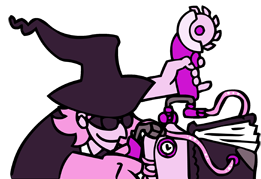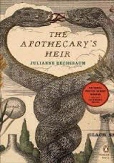reviewed by Rowyda Amin
Buchsbaum's third collection: impressive for some of its achievements, a little misty at times
The Apothecary’s Heir is Julianne Buchsbaum’s third collection and was published by Penguin as part of the National Poetry Series, the manuscript having been selected by Lucie Brock-Broido. Reminiscent of Wallace Stevens in her precision of language and breadth of vocabulary, Buchsbaum has a talent for making the commonplace transcendent. The persona that inhabits and narrates Buchsbaum’s poems is a flâneuse of marginal, small-town America, observing particularly the neglected and less-than-salubrious places: trailer parks, industrial zones, office cubicles. She refers to herself as ‘an odd discoverer’ and a ‘lexicographer of decay’. Of solitary nature, this persona pays close attention to the things of the world around her and renders them in meditative lyric poems that are baroque in their richness of description.
Buchsbaum, like Keats, values beauty above all else in her poems, but her aesthetic is resolutely democratic in a manner that she wishes to contrast with that of Keats
This attention to what might generally be considered unremarkable brings to mind George Eliot’s words in Middlemarch: ‘[W]e do not expect people to be moved by what is not unusual. That element of tragedy which lies in the very fact of frequency, has not yet wrought itself into the coarse emotion of mankind.’ Buchsbaum’s poems focus on the resolutely usual, drawing attention to mundane places in such a way that they seem startling and fresh, without recourse to the games of hide-and-seek used by the ‘Martian’ poets of the Seventies and Eighties to defamiliarise the everyday. Arresting and unusual description is the tool here, as in the poem ‘Three Brief Meditations on Oak Trees’ in which Buchsbaum writes: ‘I love the briny / lowercase letters of the snow’, or in ‘And My Clothing Shall Be Cruelty’, in which ‘parks pullulate with germs, larvae; / The sapsucker taps the thawed resin.’ It is as though every object the narrator meets is viewed through a magnifying lens so that it is simultaneously rendered minutely clear and also distorted into grotesque but beautiful strangeness.
In a poem entitled ‘Ars Poetica’, Buchsbaum likens the poet’s work to that of a surgeon: ‘Where is the needle, the ligature fine enough / to stitch the wound between word and thing?’ The ambition of Buchsbaum’s project is daunting, and in this poem she questions her skills: ‘Am I the surgeon to suture such a gaping?’ Notional perfection, she concedes, is beside the point. It is the striving after it that creates the poem:
I disinfect my scalpels in the autoclave
of solitude; the room reeks of phenol –
but hygiene is not enough …
Let the squeamish keep their lab coats clean.
I mask my face and swab at the blood-leaks.
The poems are in keeping with Buchsbaum’s objectives, although at times they suffer from a lack of forward movement and from a density verging on opacity. ‘Leaflet’, ‘Infant Dusk’ and ‘The Day After’ are examples of this tendency. The most successful poems are those which take the form of sustained meditations on places and things in which the focus does not shift too abruptly or randomly, as in ‘The Weeds of Walker’s Point’, ‘The Mad Dream of Sea-Things in the Bay of Bengal’ and ‘Summer of Fires.
There are some themes which are woven through the collection and considered in more than one poem. One of these is asceticism, with the narrator being simultaneously attracted to the idea and also desiring the opposite, a deeper engagement with the material world. In ‘The Making of the English Working Class’, the narrator describes her ‘long-standing withdrawal from / the present moment’ and links it with forms of magical thinking intended to make the individual and the community safe:
It’s possible to die from not being touched – no one
knew that then – and the monks were not to be disturbed
in their dark adorations, their ancient formulas
for making something potent go away, be quiet, good.
The titular figure of the apothecary reappears several times in the collection. In ‘Eve of Darkness’, night ‘is the only rightful heir and apothecary’ of a ‘shattered moment’. In ‘Summer of Fires’, the narrator addresses the season: ‘I’m putting / you to sleep in my arms with some opium’ and in ‘One Last Daystar Fades’ an old apothecary is ‘a wild-looking prefiguration / of suffering, a tattered / and malefic one presiding / over cool bottles of multicoloured pills.’ The apothecary, whose role was a precursor to the modern medical profession, mixed and dispensed medicines made from natural ingredients. Throughout this collection, Buchsbaum contrasts images of purity, hygiene and nature with images of decay, disease and pollution. The poems themselves can be seen as potions against these blights, and the poet as the apothecary’s heir.
This collection abounds in references to classical mythology and the canon of English literature. One such poem, ‘Ode on a Mode of Lethe’, alludes to Keats’s ‘Ode to a Nightingale’, and can be seen as a revealing extension of Buchsbaum’s ‘Ars Poetica’:
A mode of Lethe washes over me,
engorging me with feeling for lyric
poetry. It’s like a nightingale trapped
in a sewer pipe, struggling to get free.
…
In darkness embalmed with the smell of exhaust
fumes and chemicals, there is the softer smell
of turbines. O, for a cup completely full of the sun.
The thought that I could drink it inside
The visible world leaves me weak at the knees.
Buchsbaum would seem to be an advocate of what Keats termed ‘Negative Capability’ and defined as follows: ‘[W]hen a man is capable of being in uncertainties, mysteries, doubts, without any irritable reaching after fact … with a great poet the sense of Beauty overcomes every other consideration, or rather obliterates all consideration.’ In her homage to ‘Ode to a Nightingale’, however, Buchsbaum sets out her differences, which are both aesthetic and political. Buchsbaum, like Keats, values beauty above all else in her poems, but her aesthetic is resolutely democratic in a manner that she wishes to contrast with that of Keats. Beauty, Buchsbaum’s ode exhorts, is all the more delightful for connecting the observer more strongly to quotidian reality, ‘the visible world,’ rather than inspiring escapist desires, such Keats’s ‘easeful Death’. At the end of the poem, Buchsbaum’s narrator addresses the nightingale: ‘But your excessive happiness annoys me, / bird, plotting to flee from all this umbrage.’ If Buchsbaum’s stated values were consistently applied, the collection would possibly be the weaker for it, but there are many moments of gritty transcendence in her poems which verge on the dream-like and fantastical, such as in ‘Eve of Darkness’:
[Y]ou who stand alone in the stains of a night
that increases in star noise like the memos
of an old hegemony, in the impossible museums
where all the cold statues do no blossoming
Buchsbaum’s mode of writing is strongly rooted in two American sources: firstly, the Modernist aesthetic of William Carlos Williams, expressed in his famous line ‘No ideas but in things’, and secondly the style currently in vogue, which Tony Hoagland described in his essay ‘Fear of Narrative and the Skittery Poem of Our Moment':
[F]ast-moving and declarative, wobbling on the balance beam between associative and dissociative, somewhat absurdist, and, indeed, cerebral. Much talent and skill are evident in its making, in its pacing and management of gaps, the hints and sound bites which keep the reader reaching forward for the lynchpin of coherence… Even as the poem implies a world without sequence, the poem itself has no consequence, no center of gravity, no body, no assertion of emotional value… [These poems ] showcase personality in the persona of their chatty, free-associating, nutty-smart narrators. It is a self that does not stand still, that implies a kind of spectral, anxious insubstantiality. The voice is plenty sharp in tone and sometimes observant in its detail, but it is skittery. Elusiveness is the speaker’s central characteristic. Speed, wit, and absurdity are its attractive qualities. The last thing such poems are going to do is risk their detachment, their distance, their freedom from accountability. The one thing they are not going to do is commit themselves to the sweaty enclosures of subject matter and the potential embarrassment of sincerity.
Buchsbaum shares this aversion to narrative, although a couple of poems, including ‘Lakeshore Hospital 1987: A Dialogue of Self and Soul’ do contain relatively coherent characterisation and narrative. Overall, though, the skittish refusal of narrative, and hierarchies of value in these poems places them within this dominant mode. Buchsbaum’s poems are enjoyable because of her talent at conjuring beautiful and unexpected word-images, and the collection is given greater coherence by having some recurring themes. Buchsbaum plays to her strengths, but the consequence is that the combination of dissociation and a focus on creating, but not necessarily linking or ordering, images means that much of the time the poems skate lightly over an opaque surface, allowing the reader little more than superficial enjoyment of the beautiful words and pictures.










